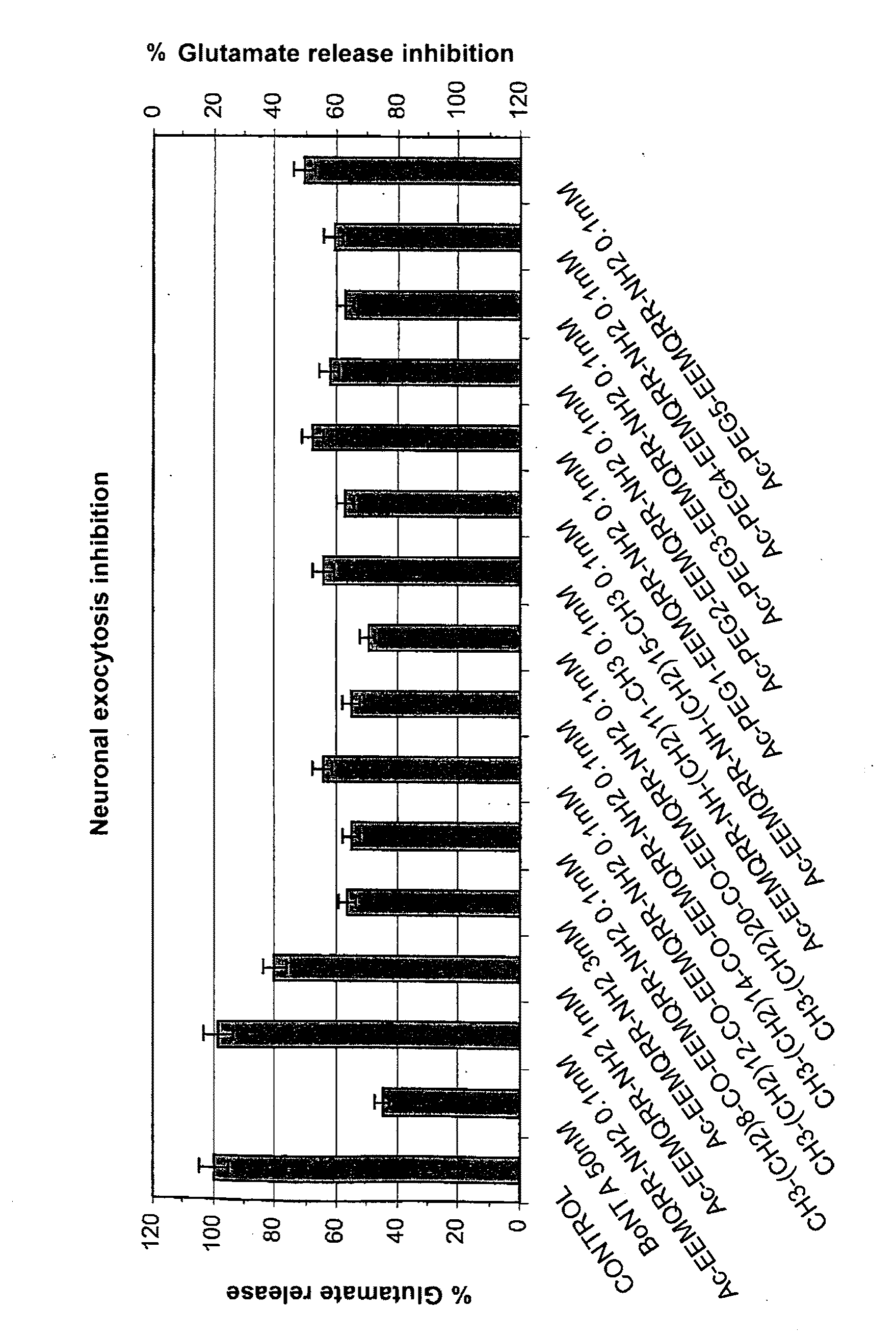Neuronal exocytosis inhibiting peptides
a technology of neurotransmitter and exocytosis, which is applied in the field of peptides, can solve the problems of nervous hyperactivity, limited efficacy in preventing and treating facial wrinkles caused by muscle contraction, and uncontrolled and excessive release of neurotransmitters
- Summary
- Abstract
- Description
- Claims
- Application Information
AI Technical Summary
Benefits of technology
Problems solved by technology
Method used
Image
Examples
embodiments
[0070]The following specific examples provided herein are useful for illustrating the nature of the present invention. These examples are included solely for illustrative purposes and must not be interpreted as limitations to the invention claimed herein.
General Methodology
[0071]All the synthetic processes are carried out in polypropylene syringes equipped with porous polyethylene disks. All the reagents and solvents are of a quality for synthesis and are used without any additional treatment. The solvents and reagents are eliminated by suction. The elimination of the Fmoc group is carried out with piperidine-DMF (2:8, v / v) (1×1 min, 1×5 min; 5 mL / g resin) [Lloyd-Williams P., Albericio F. and Giralt, E. (1997) “Chemical Approaches to the Synthesis of Peptides and Proteins” CRC, Boca Raton (Fla., USA)]. The washings between the steps of deprotection, coupling and once again deprotection have been carried out with DMF (3×1 min) using 10 mL of solvent / g of resin. The ...
example 1
Obtaining Fmoc-Glu(OtBu)-Glu(OtBu)-Met-Gln-Arg(Pbf)-Arg(Pbo-AM-MBHA
[0075]151.3 g of the Fmoc-AM-MBHA resin with a functionalization of 0.628 mmol / g (95 mmol, 1 eq.) are treated with piperidine-DMF according to the described general protocol for the purpose of eliminating the Fmoc group. 154.1 g of Fmoc-L-Arg(Pbf)-OH (237 mmol, 2.5 eq.) are incorporated to the unprotected resin in the presence of DIPCDI (36.6 mL, 237 mmol, 2.5 eq.) and HOBt (35.6 g, 237 mmol, 2.5 eq.) using DMF as a solvent for 1 h.
[0076]The resin is subsequently washed as described in the general methods and the treatment for deprotecting the Fmoc group is repeated to incorporate the next amino acid. By following the described protocols, 154.1 g of Fmoc-L-Arg(Pbf)-OH (237 mmol, 2.5 eq.), 87.5 g of Fmoc-Gln-OH (474 mmol, 5 eq.), 88.2 g of Fmoc-L-Met-OH (237 mmol, 2.5 eq.), 105.3 g of Fmoc-L-Glu(OtBu)-OH (237 mmol, 2.5 eq.) and 105.3 g of Fmoc-L-Glu(OtBu)-OH (237 mmol, 2.5 eq.) are sequentially coupled with the presen...
example 3
Obtaining Ac-PEGn-Glu-Glu-Met-Gln-Arg-Arg-NH2
[0080]The amino-terminal Fmoc group of 321.0 mg of Fmoc-Glu(OtBu)-Glu(OtBu)-Met-Gln-Arg(Pbf)-Arg(Pbf)-AM-MBHA (0.095 mmol, 0.296 mmol / g, 1 eq.) is deprotected as described in general methods, and Fmoc-PEG1-OH (2.5 eq.) predissolved in NMP, is added in the presence of 36.5 mg of HOBt (0.237 mmol, 2.5 eq.) and 36.6 μL of DIPCDI (0.237 mmol, 2.5 eq.), for 40-60 min. The amino-terminal Fmoc group as describe in general methods and the reaction for incorporating Fmoc-PEG1-OH and the dsprotection of Fmoc is carried out (n−1) times, where n=1-100 to obtain the different derivatives. The acetylation of amino-terminal end is carried out with con Ac2O (2.5 eq.) and DIEA (2.5 eq.) in DMF for 30 min.
[0081]The Ac-PEGn-Glu(OtBu)-Glu(OtBu)-Met-Gln-Arg(Pbf)-Arg(Pbf)-AM-MBHA resin is washed with DMF (5×1 min), DCM (4×1 min), diethyl ether (4×1 min) and is dried under vacuum.
[0082]22.4 mg of Ac-PEGn-Glu(OtBu)-Glu(OtBu)-Met-Gln-Arg(Pbf)-Arg(Pbf)-AM-MBHA a...
PUM
| Property | Measurement | Unit |
|---|---|---|
| molecular weight | aaaaa | aaaaa |
| molecular weight | aaaaa | aaaaa |
| width | aaaaa | aaaaa |
Abstract
Description
Claims
Application Information
 Login to View More
Login to View More - R&D
- Intellectual Property
- Life Sciences
- Materials
- Tech Scout
- Unparalleled Data Quality
- Higher Quality Content
- 60% Fewer Hallucinations
Browse by: Latest US Patents, China's latest patents, Technical Efficacy Thesaurus, Application Domain, Technology Topic, Popular Technical Reports.
© 2025 PatSnap. All rights reserved.Legal|Privacy policy|Modern Slavery Act Transparency Statement|Sitemap|About US| Contact US: help@patsnap.com



